SBM3301 Report: Analyzing Innovation and Creativity in Australia
VerifiedAdded on 2023/06/04
|11
|2581
|154
Report
AI Summary
This report provides a comprehensive analysis of innovation and creativity in Australia, focusing on its significance in both society and the business sector. It defines innovation and creativity, highlighting their crucial role in economic growth and problem-solving. The report emphasizes the importance of government investment in fostering a culture of innovation and creativity, examining the benefits such as economic growth, new product development, and social well-being. It also addresses the challenges associated with promoting innovation, including uncertainty, the need for robust innovation strategies, and workforce diversity. The report concludes by reiterating the importance of innovation and creativity for Australia's economic and social progress, emphasizing the need for continuous development and investment in these areas.
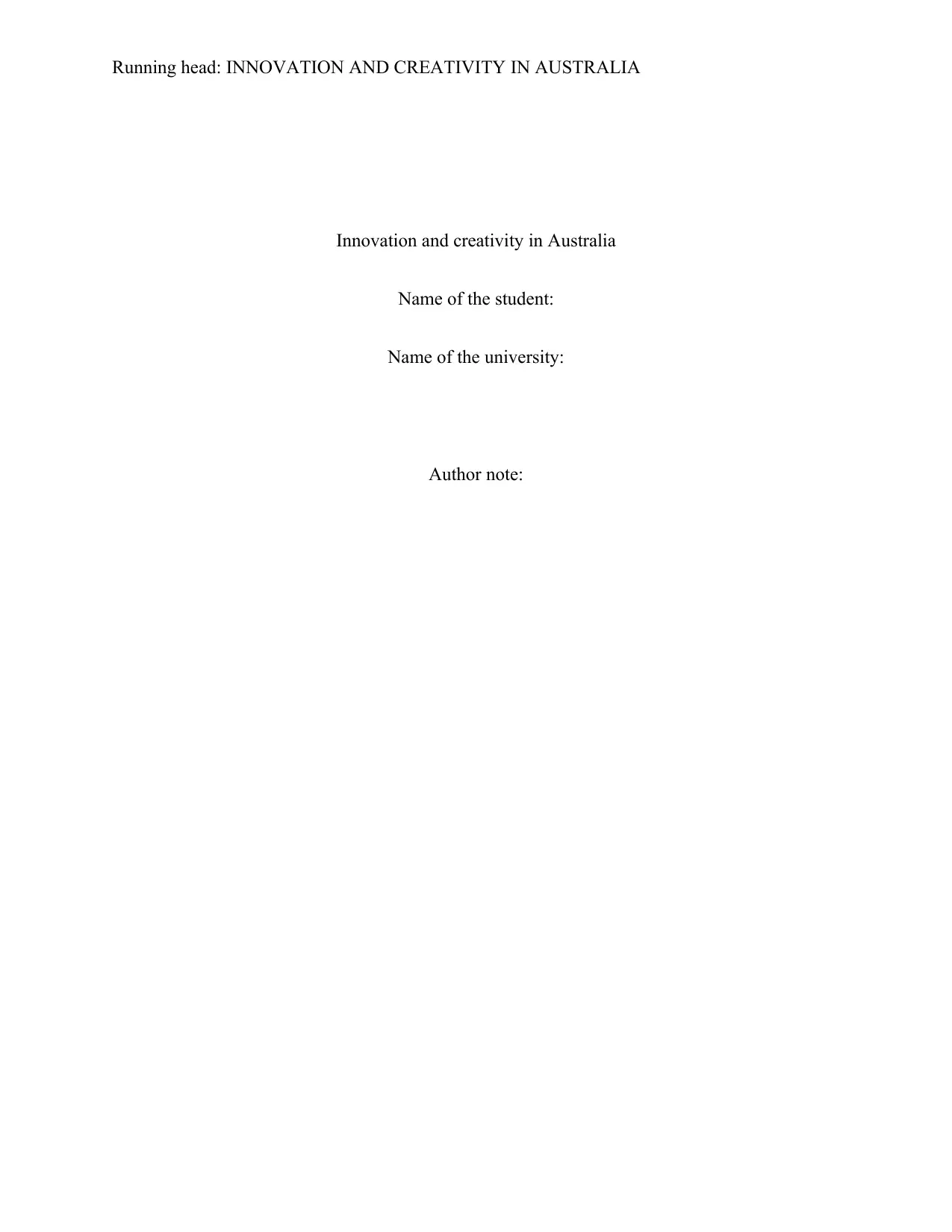
Running head: INNOVATION AND CREATIVITY IN AUSTRALIA
Innovation and creativity in Australia
Name of the student:
Name of the university:
Author note:
Innovation and creativity in Australia
Name of the student:
Name of the university:
Author note:
Paraphrase This Document
Need a fresh take? Get an instant paraphrase of this document with our AI Paraphraser
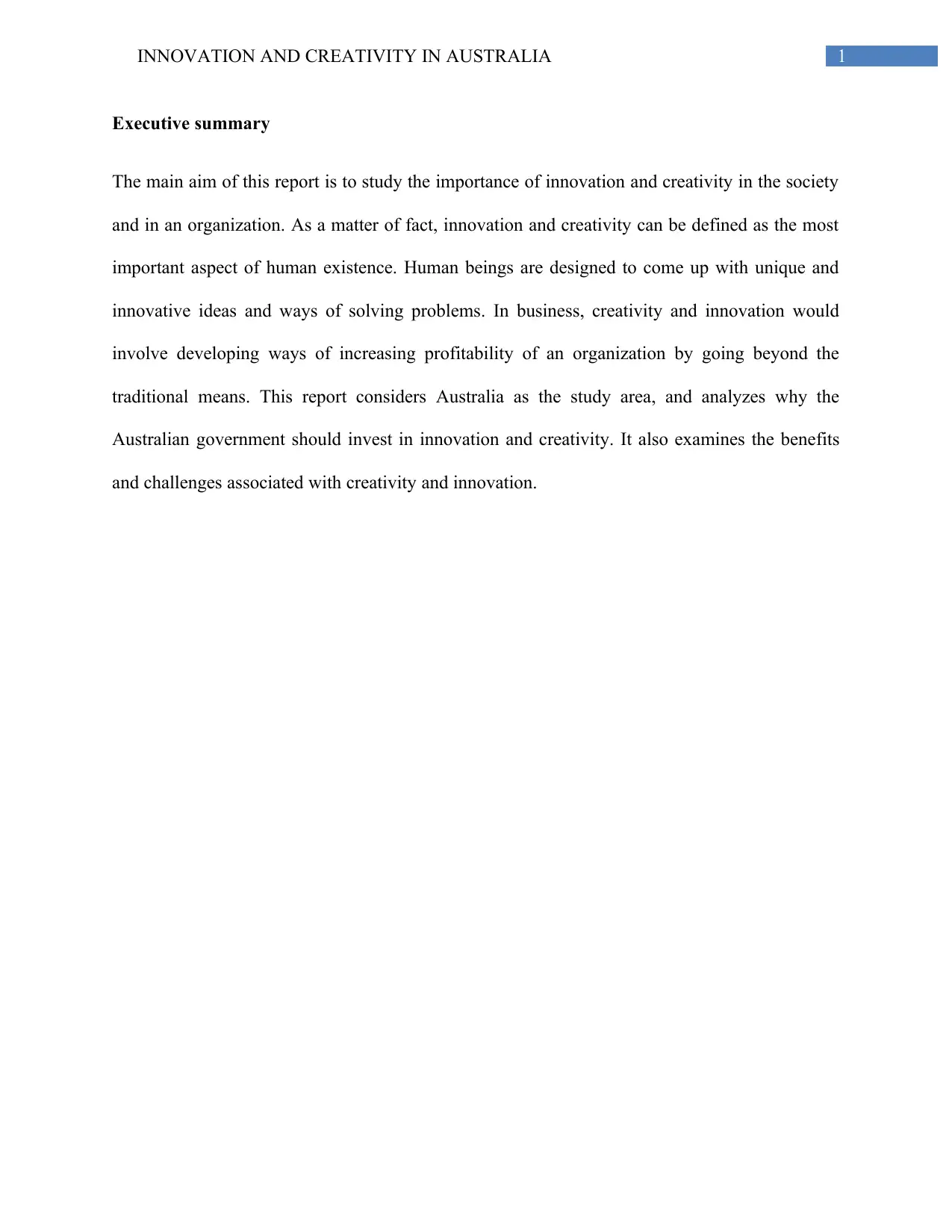
1INNOVATION AND CREATIVITY IN AUSTRALIA
Executive summary
The main aim of this report is to study the importance of innovation and creativity in the society
and in an organization. As a matter of fact, innovation and creativity can be defined as the most
important aspect of human existence. Human beings are designed to come up with unique and
innovative ideas and ways of solving problems. In business, creativity and innovation would
involve developing ways of increasing profitability of an organization by going beyond the
traditional means. This report considers Australia as the study area, and analyzes why the
Australian government should invest in innovation and creativity. It also examines the benefits
and challenges associated with creativity and innovation.
Executive summary
The main aim of this report is to study the importance of innovation and creativity in the society
and in an organization. As a matter of fact, innovation and creativity can be defined as the most
important aspect of human existence. Human beings are designed to come up with unique and
innovative ideas and ways of solving problems. In business, creativity and innovation would
involve developing ways of increasing profitability of an organization by going beyond the
traditional means. This report considers Australia as the study area, and analyzes why the
Australian government should invest in innovation and creativity. It also examines the benefits
and challenges associated with creativity and innovation.

2INNOVATION AND CREATIVITY IN AUSTRALIA
Table of Contents
Introduction:....................................................................................................................................3
Discussion........................................................................................................................................3
The importance of investing in corporate innovation and creativity...........................................3
Facilitating creativity and innovation..........................................................................................5
Benefits of investing in innovation and creativity.......................................................................6
Challenges of promoting innovation and creativity.....................................................................7
Conclusion:......................................................................................................................................8
References:......................................................................................................................................8
Table of Contents
Introduction:....................................................................................................................................3
Discussion........................................................................................................................................3
The importance of investing in corporate innovation and creativity...........................................3
Facilitating creativity and innovation..........................................................................................5
Benefits of investing in innovation and creativity.......................................................................6
Challenges of promoting innovation and creativity.....................................................................7
Conclusion:......................................................................................................................................8
References:......................................................................................................................................8
⊘ This is a preview!⊘
Do you want full access?
Subscribe today to unlock all pages.

Trusted by 1+ million students worldwide
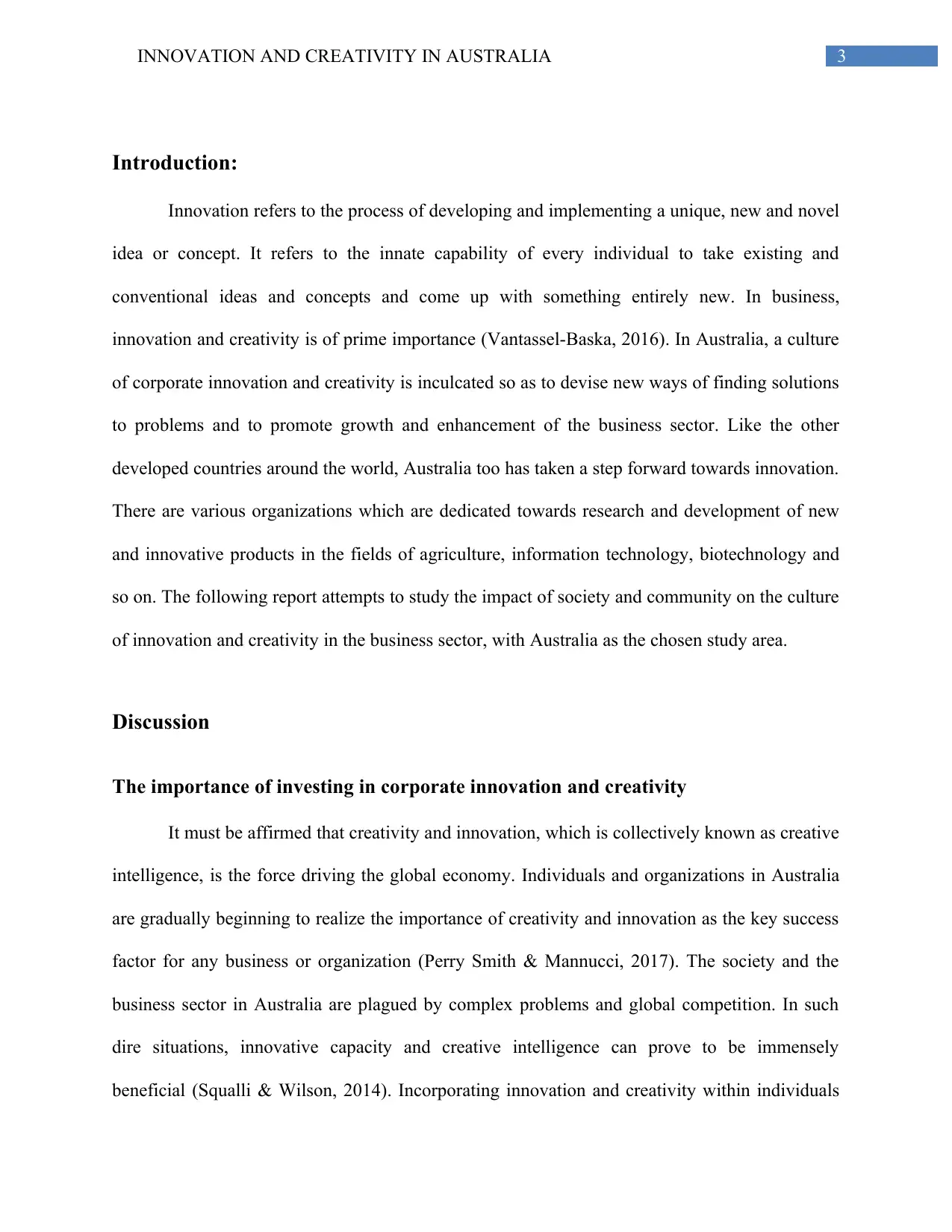
3INNOVATION AND CREATIVITY IN AUSTRALIA
Introduction:
Innovation refers to the process of developing and implementing a unique, new and novel
idea or concept. It refers to the innate capability of every individual to take existing and
conventional ideas and concepts and come up with something entirely new. In business,
innovation and creativity is of prime importance (Vantassel-Baska, 2016). In Australia, a culture
of corporate innovation and creativity is inculcated so as to devise new ways of finding solutions
to problems and to promote growth and enhancement of the business sector. Like the other
developed countries around the world, Australia too has taken a step forward towards innovation.
There are various organizations which are dedicated towards research and development of new
and innovative products in the fields of agriculture, information technology, biotechnology and
so on. The following report attempts to study the impact of society and community on the culture
of innovation and creativity in the business sector, with Australia as the chosen study area.
Discussion
The importance of investing in corporate innovation and creativity
It must be affirmed that creativity and innovation, which is collectively known as creative
intelligence, is the force driving the global economy. Individuals and organizations in Australia
are gradually beginning to realize the importance of creativity and innovation as the key success
factor for any business or organization (Perry Smith & Mannucci, 2017). The society and the
business sector in Australia are plagued by complex problems and global competition. In such
dire situations, innovative capacity and creative intelligence can prove to be immensely
beneficial (Squalli & Wilson, 2014). Incorporating innovation and creativity within individuals
Introduction:
Innovation refers to the process of developing and implementing a unique, new and novel
idea or concept. It refers to the innate capability of every individual to take existing and
conventional ideas and concepts and come up with something entirely new. In business,
innovation and creativity is of prime importance (Vantassel-Baska, 2016). In Australia, a culture
of corporate innovation and creativity is inculcated so as to devise new ways of finding solutions
to problems and to promote growth and enhancement of the business sector. Like the other
developed countries around the world, Australia too has taken a step forward towards innovation.
There are various organizations which are dedicated towards research and development of new
and innovative products in the fields of agriculture, information technology, biotechnology and
so on. The following report attempts to study the impact of society and community on the culture
of innovation and creativity in the business sector, with Australia as the chosen study area.
Discussion
The importance of investing in corporate innovation and creativity
It must be affirmed that creativity and innovation, which is collectively known as creative
intelligence, is the force driving the global economy. Individuals and organizations in Australia
are gradually beginning to realize the importance of creativity and innovation as the key success
factor for any business or organization (Perry Smith & Mannucci, 2017). The society and the
business sector in Australia are plagued by complex problems and global competition. In such
dire situations, innovative capacity and creative intelligence can prove to be immensely
beneficial (Squalli & Wilson, 2014). Incorporating innovation and creativity within individuals
Paraphrase This Document
Need a fresh take? Get an instant paraphrase of this document with our AI Paraphraser
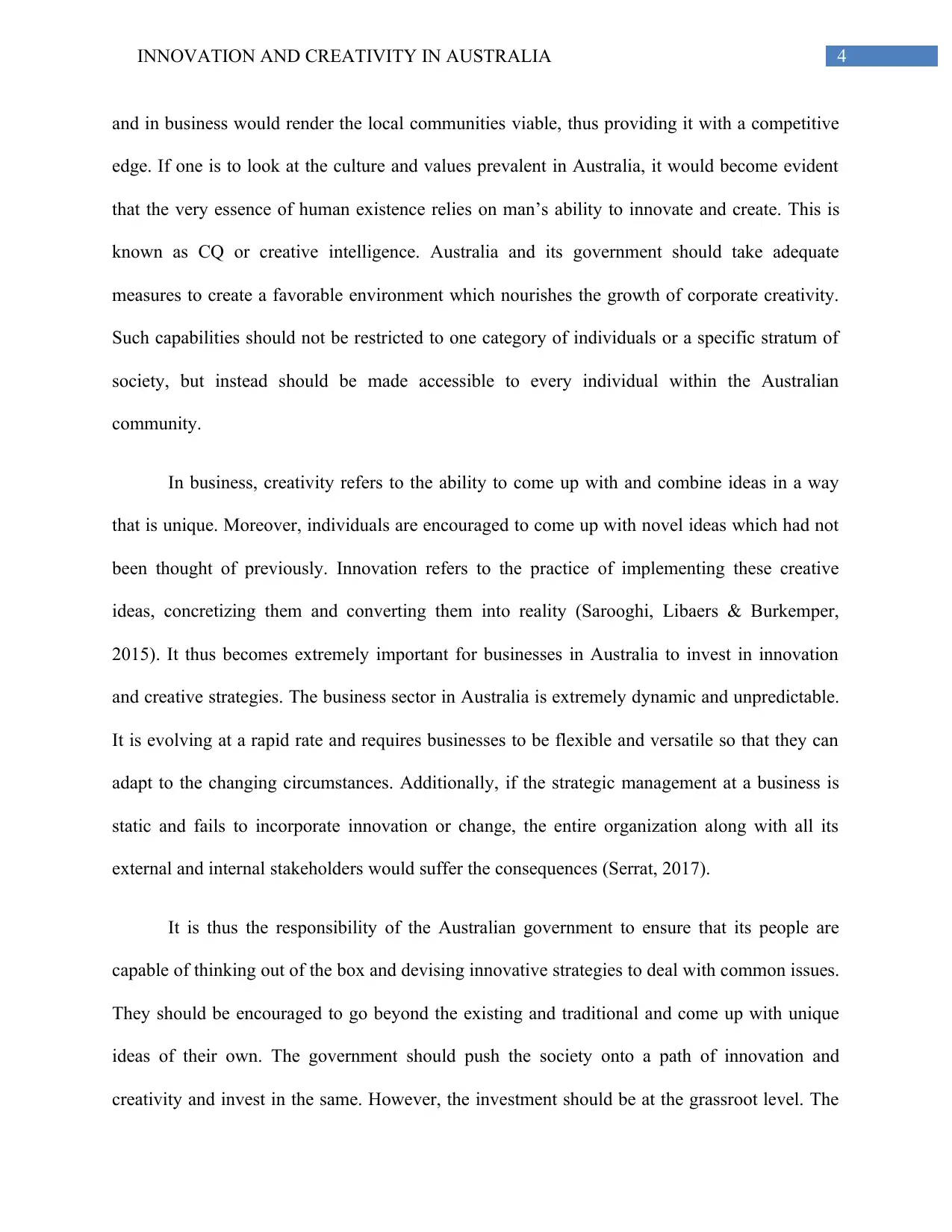
4INNOVATION AND CREATIVITY IN AUSTRALIA
and in business would render the local communities viable, thus providing it with a competitive
edge. If one is to look at the culture and values prevalent in Australia, it would become evident
that the very essence of human existence relies on man’s ability to innovate and create. This is
known as CQ or creative intelligence. Australia and its government should take adequate
measures to create a favorable environment which nourishes the growth of corporate creativity.
Such capabilities should not be restricted to one category of individuals or a specific stratum of
society, but instead should be made accessible to every individual within the Australian
community.
In business, creativity refers to the ability to come up with and combine ideas in a way
that is unique. Moreover, individuals are encouraged to come up with novel ideas which had not
been thought of previously. Innovation refers to the practice of implementing these creative
ideas, concretizing them and converting them into reality (Sarooghi, Libaers & Burkemper,
2015). It thus becomes extremely important for businesses in Australia to invest in innovation
and creative strategies. The business sector in Australia is extremely dynamic and unpredictable.
It is evolving at a rapid rate and requires businesses to be flexible and versatile so that they can
adapt to the changing circumstances. Additionally, if the strategic management at a business is
static and fails to incorporate innovation or change, the entire organization along with all its
external and internal stakeholders would suffer the consequences (Serrat, 2017).
It is thus the responsibility of the Australian government to ensure that its people are
capable of thinking out of the box and devising innovative strategies to deal with common issues.
They should be encouraged to go beyond the existing and traditional and come up with unique
ideas of their own. The government should push the society onto a path of innovation and
creativity and invest in the same. However, the investment should be at the grassroot level. The
and in business would render the local communities viable, thus providing it with a competitive
edge. If one is to look at the culture and values prevalent in Australia, it would become evident
that the very essence of human existence relies on man’s ability to innovate and create. This is
known as CQ or creative intelligence. Australia and its government should take adequate
measures to create a favorable environment which nourishes the growth of corporate creativity.
Such capabilities should not be restricted to one category of individuals or a specific stratum of
society, but instead should be made accessible to every individual within the Australian
community.
In business, creativity refers to the ability to come up with and combine ideas in a way
that is unique. Moreover, individuals are encouraged to come up with novel ideas which had not
been thought of previously. Innovation refers to the practice of implementing these creative
ideas, concretizing them and converting them into reality (Sarooghi, Libaers & Burkemper,
2015). It thus becomes extremely important for businesses in Australia to invest in innovation
and creative strategies. The business sector in Australia is extremely dynamic and unpredictable.
It is evolving at a rapid rate and requires businesses to be flexible and versatile so that they can
adapt to the changing circumstances. Additionally, if the strategic management at a business is
static and fails to incorporate innovation or change, the entire organization along with all its
external and internal stakeholders would suffer the consequences (Serrat, 2017).
It is thus the responsibility of the Australian government to ensure that its people are
capable of thinking out of the box and devising innovative strategies to deal with common issues.
They should be encouraged to go beyond the existing and traditional and come up with unique
ideas of their own. The government should push the society onto a path of innovation and
creativity and invest in the same. However, the investment should be at the grassroot level. The
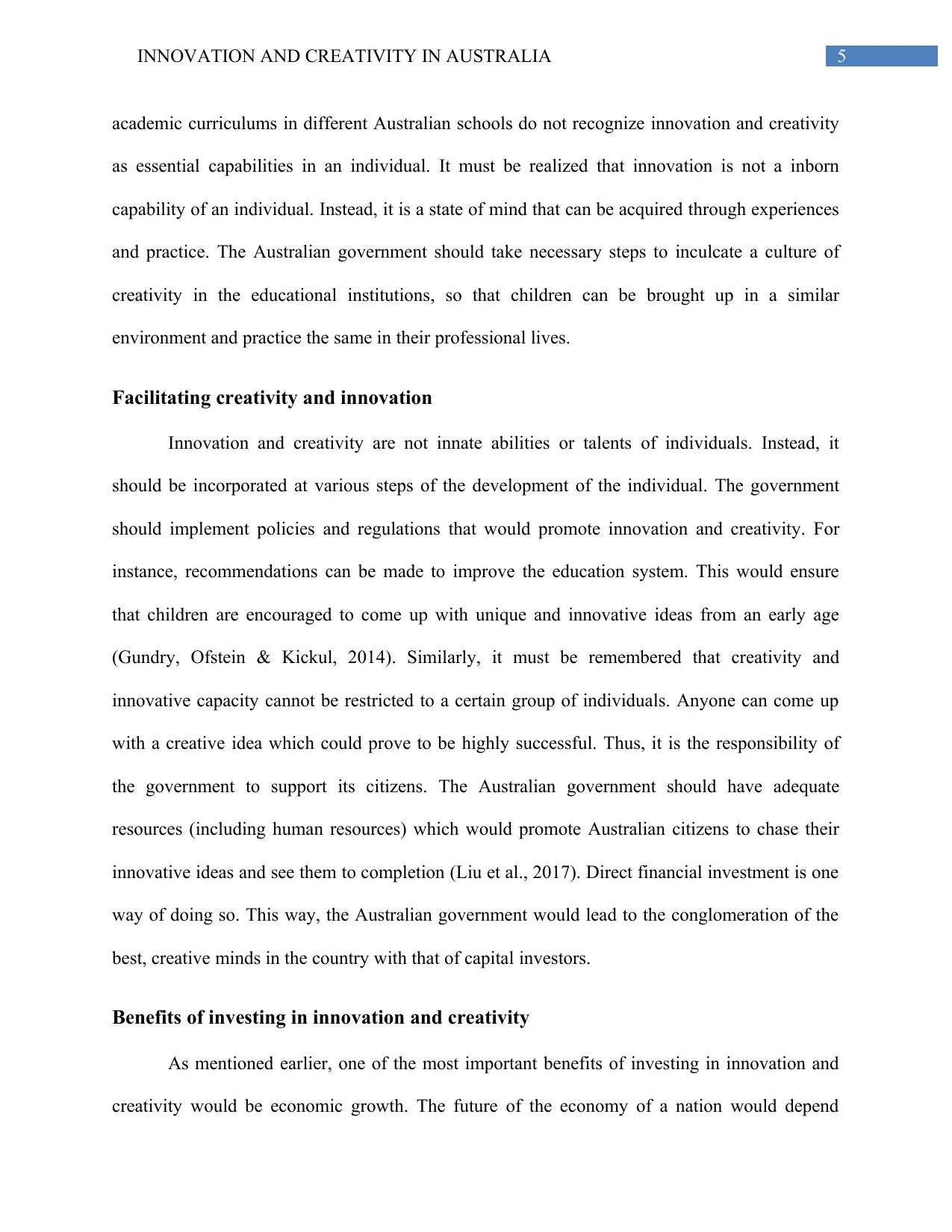
5INNOVATION AND CREATIVITY IN AUSTRALIA
academic curriculums in different Australian schools do not recognize innovation and creativity
as essential capabilities in an individual. It must be realized that innovation is not a inborn
capability of an individual. Instead, it is a state of mind that can be acquired through experiences
and practice. The Australian government should take necessary steps to inculcate a culture of
creativity in the educational institutions, so that children can be brought up in a similar
environment and practice the same in their professional lives.
Facilitating creativity and innovation
Innovation and creativity are not innate abilities or talents of individuals. Instead, it
should be incorporated at various steps of the development of the individual. The government
should implement policies and regulations that would promote innovation and creativity. For
instance, recommendations can be made to improve the education system. This would ensure
that children are encouraged to come up with unique and innovative ideas from an early age
(Gundry, Ofstein & Kickul, 2014). Similarly, it must be remembered that creativity and
innovative capacity cannot be restricted to a certain group of individuals. Anyone can come up
with a creative idea which could prove to be highly successful. Thus, it is the responsibility of
the government to support its citizens. The Australian government should have adequate
resources (including human resources) which would promote Australian citizens to chase their
innovative ideas and see them to completion (Liu et al., 2017). Direct financial investment is one
way of doing so. This way, the Australian government would lead to the conglomeration of the
best, creative minds in the country with that of capital investors.
Benefits of investing in innovation and creativity
As mentioned earlier, one of the most important benefits of investing in innovation and
creativity would be economic growth. The future of the economy of a nation would depend
academic curriculums in different Australian schools do not recognize innovation and creativity
as essential capabilities in an individual. It must be realized that innovation is not a inborn
capability of an individual. Instead, it is a state of mind that can be acquired through experiences
and practice. The Australian government should take necessary steps to inculcate a culture of
creativity in the educational institutions, so that children can be brought up in a similar
environment and practice the same in their professional lives.
Facilitating creativity and innovation
Innovation and creativity are not innate abilities or talents of individuals. Instead, it
should be incorporated at various steps of the development of the individual. The government
should implement policies and regulations that would promote innovation and creativity. For
instance, recommendations can be made to improve the education system. This would ensure
that children are encouraged to come up with unique and innovative ideas from an early age
(Gundry, Ofstein & Kickul, 2014). Similarly, it must be remembered that creativity and
innovative capacity cannot be restricted to a certain group of individuals. Anyone can come up
with a creative idea which could prove to be highly successful. Thus, it is the responsibility of
the government to support its citizens. The Australian government should have adequate
resources (including human resources) which would promote Australian citizens to chase their
innovative ideas and see them to completion (Liu et al., 2017). Direct financial investment is one
way of doing so. This way, the Australian government would lead to the conglomeration of the
best, creative minds in the country with that of capital investors.
Benefits of investing in innovation and creativity
As mentioned earlier, one of the most important benefits of investing in innovation and
creativity would be economic growth. The future of the economy of a nation would depend
⊘ This is a preview!⊘
Do you want full access?
Subscribe today to unlock all pages.

Trusted by 1+ million students worldwide
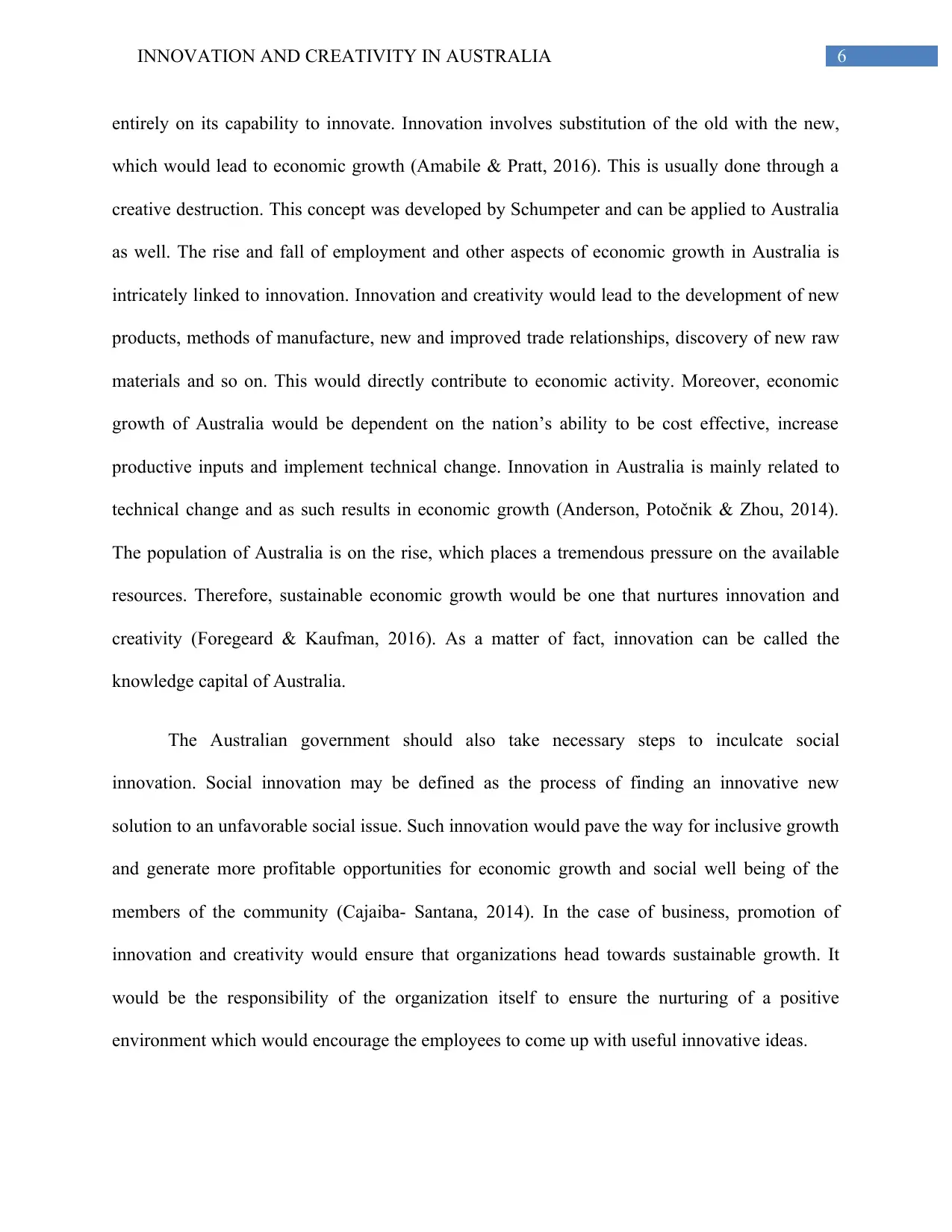
6INNOVATION AND CREATIVITY IN AUSTRALIA
entirely on its capability to innovate. Innovation involves substitution of the old with the new,
which would lead to economic growth (Amabile & Pratt, 2016). This is usually done through a
creative destruction. This concept was developed by Schumpeter and can be applied to Australia
as well. The rise and fall of employment and other aspects of economic growth in Australia is
intricately linked to innovation. Innovation and creativity would lead to the development of new
products, methods of manufacture, new and improved trade relationships, discovery of new raw
materials and so on. This would directly contribute to economic activity. Moreover, economic
growth of Australia would be dependent on the nation’s ability to be cost effective, increase
productive inputs and implement technical change. Innovation in Australia is mainly related to
technical change and as such results in economic growth (Anderson, Potočnik & Zhou, 2014).
The population of Australia is on the rise, which places a tremendous pressure on the available
resources. Therefore, sustainable economic growth would be one that nurtures innovation and
creativity (Foregeard & Kaufman, 2016). As a matter of fact, innovation can be called the
knowledge capital of Australia.
The Australian government should also take necessary steps to inculcate social
innovation. Social innovation may be defined as the process of finding an innovative new
solution to an unfavorable social issue. Such innovation would pave the way for inclusive growth
and generate more profitable opportunities for economic growth and social well being of the
members of the community (Cajaiba- Santana, 2014). In the case of business, promotion of
innovation and creativity would ensure that organizations head towards sustainable growth. It
would be the responsibility of the organization itself to ensure the nurturing of a positive
environment which would encourage the employees to come up with useful innovative ideas.
entirely on its capability to innovate. Innovation involves substitution of the old with the new,
which would lead to economic growth (Amabile & Pratt, 2016). This is usually done through a
creative destruction. This concept was developed by Schumpeter and can be applied to Australia
as well. The rise and fall of employment and other aspects of economic growth in Australia is
intricately linked to innovation. Innovation and creativity would lead to the development of new
products, methods of manufacture, new and improved trade relationships, discovery of new raw
materials and so on. This would directly contribute to economic activity. Moreover, economic
growth of Australia would be dependent on the nation’s ability to be cost effective, increase
productive inputs and implement technical change. Innovation in Australia is mainly related to
technical change and as such results in economic growth (Anderson, Potočnik & Zhou, 2014).
The population of Australia is on the rise, which places a tremendous pressure on the available
resources. Therefore, sustainable economic growth would be one that nurtures innovation and
creativity (Foregeard & Kaufman, 2016). As a matter of fact, innovation can be called the
knowledge capital of Australia.
The Australian government should also take necessary steps to inculcate social
innovation. Social innovation may be defined as the process of finding an innovative new
solution to an unfavorable social issue. Such innovation would pave the way for inclusive growth
and generate more profitable opportunities for economic growth and social well being of the
members of the community (Cajaiba- Santana, 2014). In the case of business, promotion of
innovation and creativity would ensure that organizations head towards sustainable growth. It
would be the responsibility of the organization itself to ensure the nurturing of a positive
environment which would encourage the employees to come up with useful innovative ideas.
Paraphrase This Document
Need a fresh take? Get an instant paraphrase of this document with our AI Paraphraser
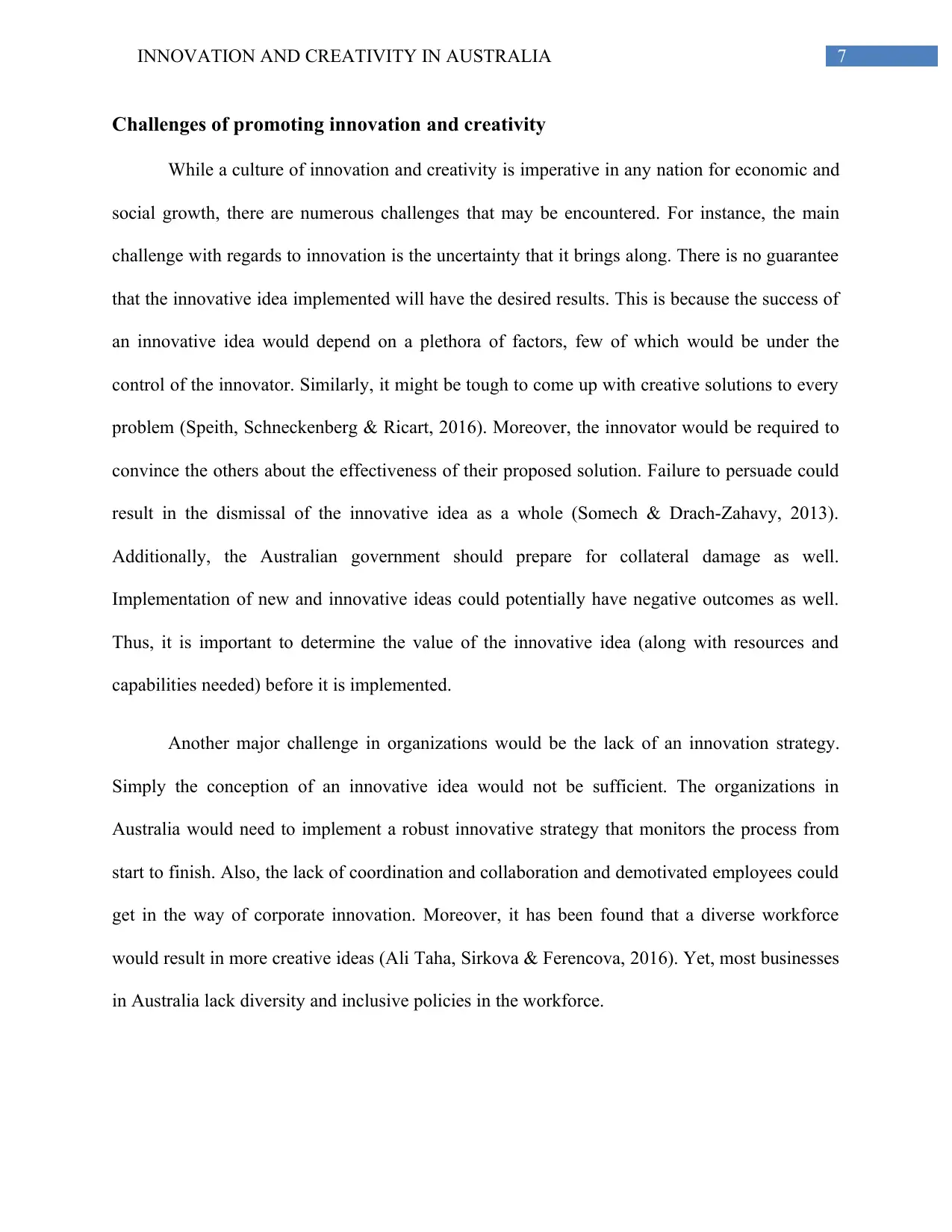
7INNOVATION AND CREATIVITY IN AUSTRALIA
Challenges of promoting innovation and creativity
While a culture of innovation and creativity is imperative in any nation for economic and
social growth, there are numerous challenges that may be encountered. For instance, the main
challenge with regards to innovation is the uncertainty that it brings along. There is no guarantee
that the innovative idea implemented will have the desired results. This is because the success of
an innovative idea would depend on a plethora of factors, few of which would be under the
control of the innovator. Similarly, it might be tough to come up with creative solutions to every
problem (Speith, Schneckenberg & Ricart, 2016). Moreover, the innovator would be required to
convince the others about the effectiveness of their proposed solution. Failure to persuade could
result in the dismissal of the innovative idea as a whole (Somech & Drach-Zahavy, 2013).
Additionally, the Australian government should prepare for collateral damage as well.
Implementation of new and innovative ideas could potentially have negative outcomes as well.
Thus, it is important to determine the value of the innovative idea (along with resources and
capabilities needed) before it is implemented.
Another major challenge in organizations would be the lack of an innovation strategy.
Simply the conception of an innovative idea would not be sufficient. The organizations in
Australia would need to implement a robust innovative strategy that monitors the process from
start to finish. Also, the lack of coordination and collaboration and demotivated employees could
get in the way of corporate innovation. Moreover, it has been found that a diverse workforce
would result in more creative ideas (Ali Taha, Sirkova & Ferencova, 2016). Yet, most businesses
in Australia lack diversity and inclusive policies in the workforce.
Challenges of promoting innovation and creativity
While a culture of innovation and creativity is imperative in any nation for economic and
social growth, there are numerous challenges that may be encountered. For instance, the main
challenge with regards to innovation is the uncertainty that it brings along. There is no guarantee
that the innovative idea implemented will have the desired results. This is because the success of
an innovative idea would depend on a plethora of factors, few of which would be under the
control of the innovator. Similarly, it might be tough to come up with creative solutions to every
problem (Speith, Schneckenberg & Ricart, 2016). Moreover, the innovator would be required to
convince the others about the effectiveness of their proposed solution. Failure to persuade could
result in the dismissal of the innovative idea as a whole (Somech & Drach-Zahavy, 2013).
Additionally, the Australian government should prepare for collateral damage as well.
Implementation of new and innovative ideas could potentially have negative outcomes as well.
Thus, it is important to determine the value of the innovative idea (along with resources and
capabilities needed) before it is implemented.
Another major challenge in organizations would be the lack of an innovation strategy.
Simply the conception of an innovative idea would not be sufficient. The organizations in
Australia would need to implement a robust innovative strategy that monitors the process from
start to finish. Also, the lack of coordination and collaboration and demotivated employees could
get in the way of corporate innovation. Moreover, it has been found that a diverse workforce
would result in more creative ideas (Ali Taha, Sirkova & Ferencova, 2016). Yet, most businesses
in Australia lack diversity and inclusive policies in the workforce.

8INNOVATION AND CREATIVITY IN AUSTRALIA
Conclusion:
To conclude, it can be said that innovation and creativity are two of the most important
facets of human existence and business. It is important for individuals to go beyond the existing
and the conventional and instead strive to devise new and unique concepts and ideas. Every
individual is creative by nature; yet, the conventional academic curriculums fail to nourish the
creative capability of every person. In Australia, a large number of businesses are based on a
foundation of creativity and innovation because it promotes economic growth and the social well
being of the surrounding communities.
Conclusion:
To conclude, it can be said that innovation and creativity are two of the most important
facets of human existence and business. It is important for individuals to go beyond the existing
and the conventional and instead strive to devise new and unique concepts and ideas. Every
individual is creative by nature; yet, the conventional academic curriculums fail to nourish the
creative capability of every person. In Australia, a large number of businesses are based on a
foundation of creativity and innovation because it promotes economic growth and the social well
being of the surrounding communities.
⊘ This is a preview!⊘
Do you want full access?
Subscribe today to unlock all pages.

Trusted by 1+ million students worldwide
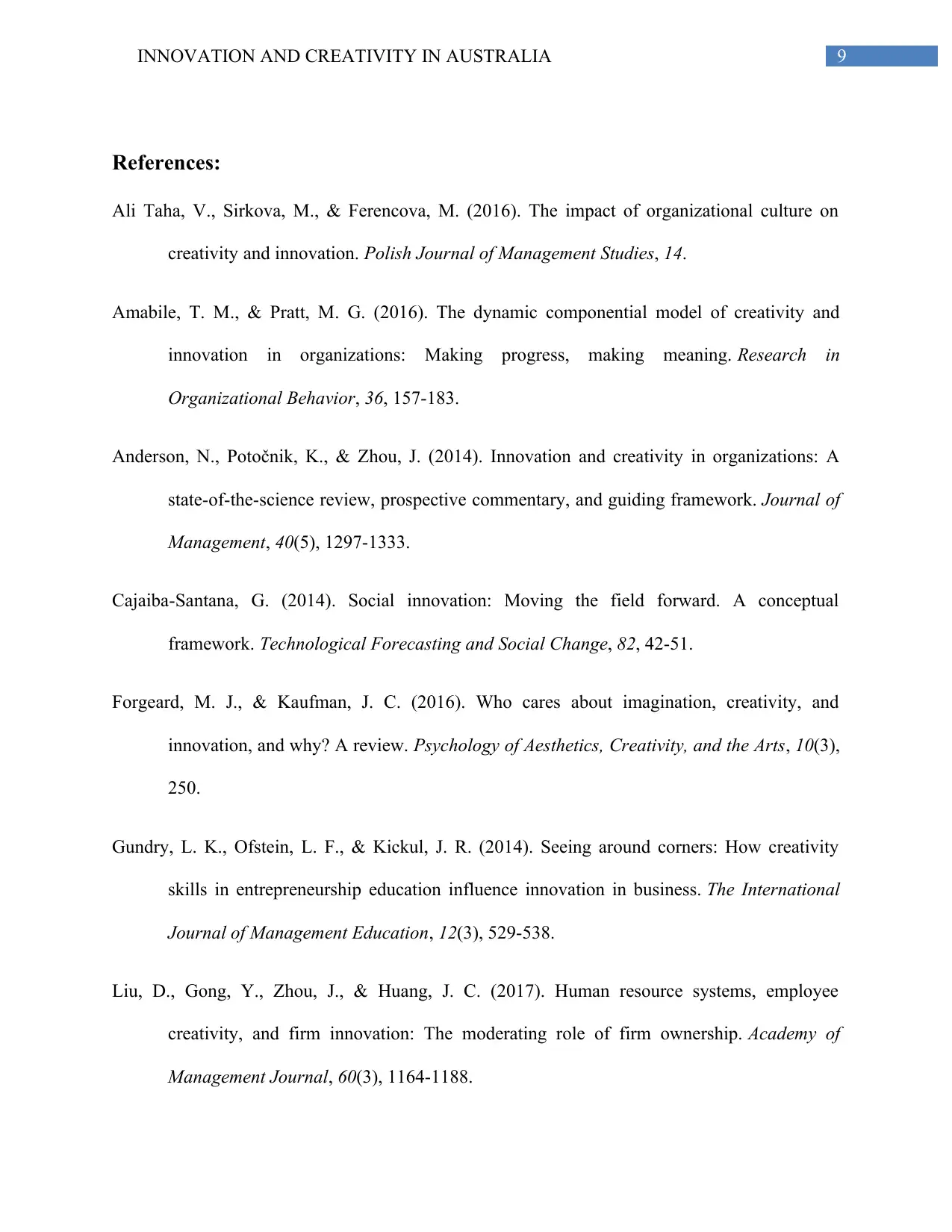
9INNOVATION AND CREATIVITY IN AUSTRALIA
References:
Ali Taha, V., Sirkova, M., & Ferencova, M. (2016). The impact of organizational culture on
creativity and innovation. Polish Journal of Management Studies, 14.
Amabile, T. M., & Pratt, M. G. (2016). The dynamic componential model of creativity and
innovation in organizations: Making progress, making meaning. Research in
Organizational Behavior, 36, 157-183.
Anderson, N., Potočnik, K., & Zhou, J. (2014). Innovation and creativity in organizations: A
state-of-the-science review, prospective commentary, and guiding framework. Journal of
Management, 40(5), 1297-1333.
Cajaiba-Santana, G. (2014). Social innovation: Moving the field forward. A conceptual
framework. Technological Forecasting and Social Change, 82, 42-51.
Forgeard, M. J., & Kaufman, J. C. (2016). Who cares about imagination, creativity, and
innovation, and why? A review. Psychology of Aesthetics, Creativity, and the Arts, 10(3),
250.
Gundry, L. K., Ofstein, L. F., & Kickul, J. R. (2014). Seeing around corners: How creativity
skills in entrepreneurship education influence innovation in business. The International
Journal of Management Education, 12(3), 529-538.
Liu, D., Gong, Y., Zhou, J., & Huang, J. C. (2017). Human resource systems, employee
creativity, and firm innovation: The moderating role of firm ownership. Academy of
Management Journal, 60(3), 1164-1188.
References:
Ali Taha, V., Sirkova, M., & Ferencova, M. (2016). The impact of organizational culture on
creativity and innovation. Polish Journal of Management Studies, 14.
Amabile, T. M., & Pratt, M. G. (2016). The dynamic componential model of creativity and
innovation in organizations: Making progress, making meaning. Research in
Organizational Behavior, 36, 157-183.
Anderson, N., Potočnik, K., & Zhou, J. (2014). Innovation and creativity in organizations: A
state-of-the-science review, prospective commentary, and guiding framework. Journal of
Management, 40(5), 1297-1333.
Cajaiba-Santana, G. (2014). Social innovation: Moving the field forward. A conceptual
framework. Technological Forecasting and Social Change, 82, 42-51.
Forgeard, M. J., & Kaufman, J. C. (2016). Who cares about imagination, creativity, and
innovation, and why? A review. Psychology of Aesthetics, Creativity, and the Arts, 10(3),
250.
Gundry, L. K., Ofstein, L. F., & Kickul, J. R. (2014). Seeing around corners: How creativity
skills in entrepreneurship education influence innovation in business. The International
Journal of Management Education, 12(3), 529-538.
Liu, D., Gong, Y., Zhou, J., & Huang, J. C. (2017). Human resource systems, employee
creativity, and firm innovation: The moderating role of firm ownership. Academy of
Management Journal, 60(3), 1164-1188.
Paraphrase This Document
Need a fresh take? Get an instant paraphrase of this document with our AI Paraphraser

10INNOVATION AND CREATIVITY IN AUSTRALIA
Perry-Smith, J. E., & Mannucci, P. V. (2017). From creativity to innovation: The social network
drivers of the four phases of the idea journey. Academy of Management Review, 42(1),
53-79.
Sarooghi, H., Libaers, D., & Burkemper, A. (2015). Examining the relationship between
creativity and innovation: A meta-analysis of organizational, cultural, and environmental
factors. Journal of business venturing, 30(5), 714-731.
Serrat, O. (2017). Harnessing creativity and innovation in the workplace. In Knowledge
Solutions (pp. 903-910). Springer, Singapore.
Somech, A., & Drach-Zahavy, A. (2013). Translating team creativity to innovation
implementation: The role of team composition and climate for innovation. Journal of
management, 39(3), 684-708.
Spieth, P., Schneckenberg, D., & Ricart, J. E. (2014). Business model innovation–state of the art
and future challenges for the field. R&d Management, 44(3), 237-247.
Squalli, J., & Wilson, K. (2014). Intelligence, creativity, and innovation. Intelligence, 46, 250-
257.
Vantassel-Baska, J. (2016). Creativity and Innovation. In Giftedness and Talent in the 21st
Century (pp. 221-223). SensePublishers, Rotterdam.
Perry-Smith, J. E., & Mannucci, P. V. (2017). From creativity to innovation: The social network
drivers of the four phases of the idea journey. Academy of Management Review, 42(1),
53-79.
Sarooghi, H., Libaers, D., & Burkemper, A. (2015). Examining the relationship between
creativity and innovation: A meta-analysis of organizational, cultural, and environmental
factors. Journal of business venturing, 30(5), 714-731.
Serrat, O. (2017). Harnessing creativity and innovation in the workplace. In Knowledge
Solutions (pp. 903-910). Springer, Singapore.
Somech, A., & Drach-Zahavy, A. (2013). Translating team creativity to innovation
implementation: The role of team composition and climate for innovation. Journal of
management, 39(3), 684-708.
Spieth, P., Schneckenberg, D., & Ricart, J. E. (2014). Business model innovation–state of the art
and future challenges for the field. R&d Management, 44(3), 237-247.
Squalli, J., & Wilson, K. (2014). Intelligence, creativity, and innovation. Intelligence, 46, 250-
257.
Vantassel-Baska, J. (2016). Creativity and Innovation. In Giftedness and Talent in the 21st
Century (pp. 221-223). SensePublishers, Rotterdam.
1 out of 11
Related Documents
Your All-in-One AI-Powered Toolkit for Academic Success.
+13062052269
info@desklib.com
Available 24*7 on WhatsApp / Email
![[object Object]](/_next/static/media/star-bottom.7253800d.svg)
Unlock your academic potential
Copyright © 2020–2025 A2Z Services. All Rights Reserved. Developed and managed by ZUCOL.





